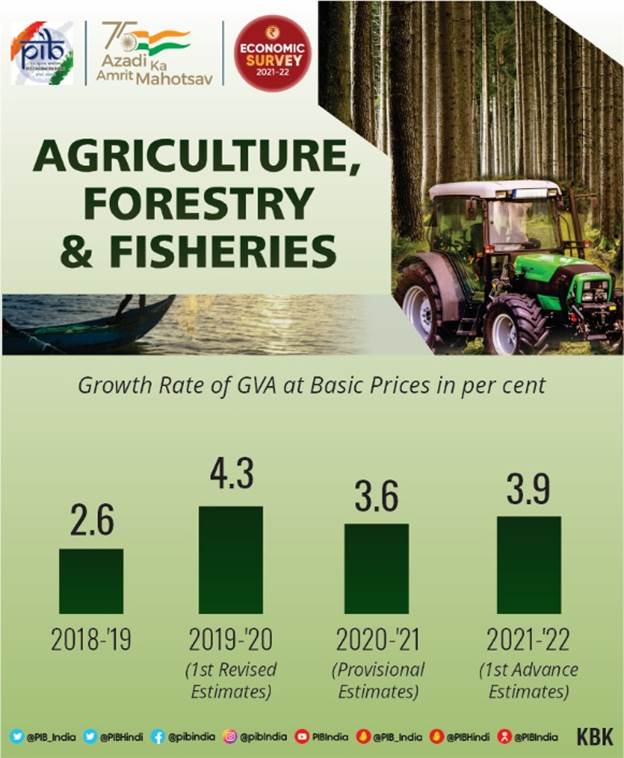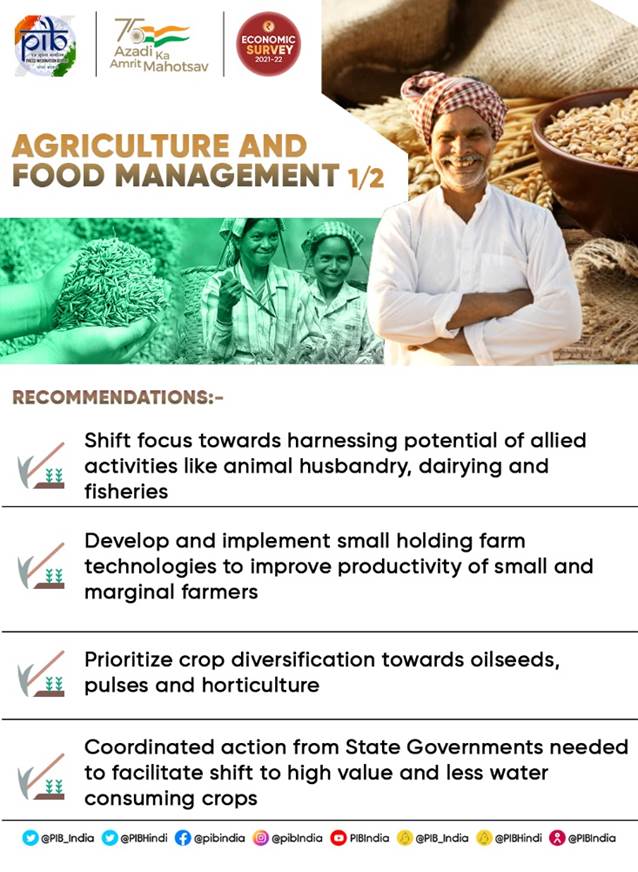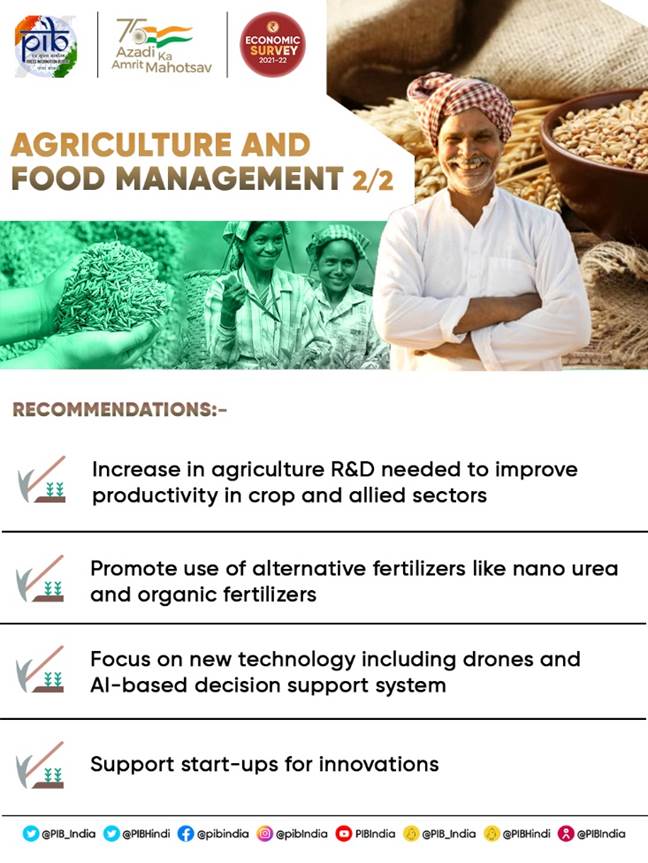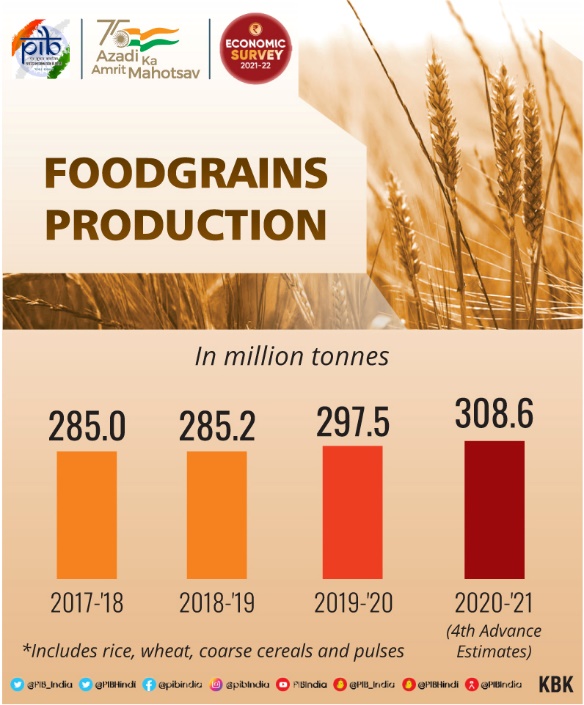Ministry of Finance
DESPITE COVID-19 SHOCK AGRICULTURE SECTOR GROWS AT 3.9% IN 2021-22 AND 3.6% IN 2020-21
GROSS VALUE ADDED IS 18.8% FOR AGRICULTURE AND ALLIED SECTORS IN 2021-22
CROP DIVERSIFICATION PROGRAMME ENVISAGES WATER CONSERVATION AND SELF-SUFFICIENCY
BHARATIYA PRAKRITIK KRISHI PADDHATI PROGRAMME FOR ECO-FRIENDLY AGRI PRODUCTION
EDIBLE OIL PRODUCTION INCREASED BY ALMOST 43% FROM 2015-16 TO 2020-21
GOVERNMENT ALLOCATED OVER 1052 LAKH TONNES OF FOOD GRAINS TO STATES/UTs UNDER NATIONAL FOOD SECURITY ACT IN 2021-22
OVER 59 LAKH HECTARES COVERED WITH MICRO-IRRIGATION UNDER PRADHAN MANTRI KRISHI SINCHAYEE YOJANA SINCE 2015-16
प्रविष्टि तिथि:
31 JAN 2022 3:01PM by PIB Delhi
The Agriculture sector which accounts for 18.8 per cent of Gross Value Added (GVA) of the country in 2021-22 has experienced buoyant growth in the past 2 years. It grew at 3.9 per cent in 2021-22 and 3.6 per cent in 2020-21 showing resilience in the face of COVID-19 shock states the Economic Survey 2021-22 tabled in the Parliament by the Union Finance & Corporate Affairs Minister, Smt. Nirmala Sitharaman today.
The Survey attributes this to “good monsoon, various Government measures to enhance credit availability, improve investments, create market facility, promote infrastructure development and increased provision of quality inputs to the sector”. It also observes that livestock and fisheries have experienced buoyant growth and had helped the sector perform well.
Gross Value Added and Gross Capital Formation
The share of the agriculture and allied sector in total GVA of the economy has settled at around 18 per cent in the long term states the Survey. In the year 2021-22 it is 18.8 per cent and in the year 2020-21 it was 20.2 per cent. Another trend observed is, higher growth in allied sectors (Livestock, Forestry and Logging, Fishing and Aquaculture) compared to the crop sector. Recognising these allied sectors as engines of high growth the Committee on Doubling Farmers’ Income (DFI 2018) had also recommended focused policy with concomitant support system to boost agricultural incomes.
The Survey notes that there is a direct correlation between capital investments in agriculture and its growth rate. The Gross Capital Formation in the agricultural sector relative to the GVA in the sector is showing a fluctuating trend in sync with the variation in private sector investments, whereas the public sector investments have remained stable at 2-3 per cent over the years. The Survey suggests “higher access to institutional credit to farmers and greater participation of the private corporate sector” may improve private sector investment in agriculture. Towards this end the Survey recommends offering appropriate policy framework to crowd-in corporate investments along with increase in public investments along the entire agricultural value chain.
Agricultural Production
The Survey states that as per the First Advance Estimates for 2021-22 (Kharif only), total food grain production is estimated at a record level of 150.50 million tonnes, an increase of 0.94 million tonnes over Kharif production in the year 2020-21. Survey also points out that the production of rice, wheat and coarse cereals had increased at Compound Annual Growth Rates (CAGR) of 2.7, 2.9 and 4.8 per cent respectively over the period between 2015-16 and 2020-21. For pulses, oilseeds and cotton during the same period it has been 7.9, 6.1 and 2.8 per cent respectively.
India is the second largest producer of sugar in the world. India has become a “sugar surplus nation” says the Survey. It points out that since 2010-11, the production has outstripped the consumption except in the year 2016-17. This has been made possible by insuring and protecting the sugarcane farmers against price risk through Fair and Remunerative Price (FRP), enhancing the liquidity of mills by incentivizing them to divert excess sugarcane/sugar to ethanol production and provide financial assistance for transport to sugar mills to facilitate export of sugar says Survey.
Crop Diversification
The Economic Survey warns that the existing cropping pattern is skewed towards cultivation of sugarcane, paddy and wheat which has led to depletion of fresh ground water resources at alarming rates, it also points out that extremely high water stress levels are recorded in the country’s north-western region.
To promote water use efficiency and sustainable agriculture and ensure higher incomes to farmers, the Government is implementing Crop Diversification Programme in the original green revolution States viz., Punjab, Haryana and Western Uttar Pradesh as a sub-scheme under Rashtriya Krishi Vikas Yojana since 2013-14 to shift area under paddy cultivation towards less water intensive crops such as oilseeds, pulses and nutri-cereals etc. The programme also focuses on shifting areas under tobacco cultivation to alternative crops in States viz. Andhra Pradesh, Bihar, Gujarat, Karnataka, Maharashtra, West Bengal among other tobacco producing states. The Survey observes that government is also using price policy to signal farmers to diversify their crops.
Water and Irrigation
The Survey points that 60 per cent of the net irrigated area in the country is serviced through groundwater. The rate of extraction of groundwater is very high (more than 100%) in the states of Delhi, Haryana, Punjab and Rajasthan. Noting that increased coverage under micro-irrigation can be the most effective mode of water conservation, the Survey suggests these States need to focus on both medium and long term ground water recharge and conservation plans.
With the objective to mobilise resources to expand coverage of micro-irrigation, a Micro-Irrigation Fund (MIF) with corpus of Rs. 5000 crores was created under NABARD during 2018-19. As on 01.12.2021, projects with loans under MIF amounting to Rs. 3970.17 crore have been approved for 12.81 lakh hectares of micro-irrigation area. Further the Survey highlights that under Pradhan Mantri Krishi Sinchayee Yojana, as on 14.12.2021 total area of 59.37 lakh hectares has been covered under micro-irrigation in the country from 2015-16.
Natural Farming
In order to sustain agricultural production through eco-friendly processes in tune with nature, ensure chemical free produce and preserve soil productivity government is also encouraging farmers to adopt natural farming techniques. Towards this end the government is implementing a dedicated scheme of Bharatiya Prakritik Krishi Paddhati Programme (BPKP) notes the Survey.
Agricultural Credit and Marketing
According to the Economic Survey, the agricultural credit flow for the year 2021-22 has been fixed at Rs. 16,50,000 crores and till 30th September 2021, against this target a sum of Rs.7,36,589.05 crores has been disbursed. Moreover, under Atma Nirbhar Bharat programme, the government also announced Rs. 2 lakh crore concessional credit boost to 2.5 crore farmers through Kisan Credit Cards (KCC). Towards this end, banks have issued KCCs to 2.70 crore eligible farmers as on 17.01.2022. Further Government has extended the KCC facility to fisheries and animal husbandry sector in 2018-19.
To link the farmers with markets and to help them in trading and realizing competitive and remunerative prices for their produce the government has been working continuously to improve market linkages and marketing infrastructure. Towards this end, the APMCs have been recognized as eligible entities under Agriculture Infrastructure Fund (AIF). Additionally under the National Agricultural Market (e-NAM) scheme as on 1st December 2021, 1000 mandis of 18 States and 3 UTs have been integrated with the e-NAM platform.

The Government has also launched a central sector scheme of ‘Formation and Promotion of 10,000 Farmer Producer Organisations (FPOs)’ to form and promote 10,000 FPOs by 2027-28. As on January 2022, a total of 1963 FPOs have been registered under the scheme. The government has also established a full-fledged Ministry of Co-operation in July 2021 with a view to provide greater focus on co-operative sector.
National Mission on Edible Oils
India is the world’s second largest consumer and number one importer of vegetable oil. The Survey highlights that the oilseed production in India has been steadily growing since 2016-17. It was showing a fluctuating trend prior to that. It had grown at almost 43 per cent from 2015-16 to 2020-21. The Economic Survey also expects that the demand for edible oil in India would remain high due to population growth, urbanization and consequent change in dietary habits and traditional meal patterns.
In view of the persistently high import of edible oil, to increase oil production the Government had been implementing a centrally sponsored scheme of National Food Security Mission: Oilseeds (NFSM - Oilseeds) since 2018-19 across all districts in the country. The Survey highlights that under the scheme the government has set up 36 oilseed hubs between 2018-19 and 2019-20 to increase availability of high yielding quality seed. For Kharif 2021, the union government had allocated 9.25 lakhs of oilseed mini kits of high yielding varieties to states for distribution. Further, in August 2021, the Government had launched National Mission on Edible Oils – Oil Palm (NMEO-OP) to augment availability of edible oils by “harnessing area expansion and through price incentives” says the Survey. The scheme aims to cover an additional area of 6.5 lakh hetares for oil palm by 2025-26 and thereby reach a target of 10 lakh hectares ultimately. The Survey points out that currently 3.70 lakh hectares is under oil palm cultivation. Also, the scheme also aims to increase the Crude Palm Oil (CPO) production to 11.20 lakh tonnes by 2025-26 and up to 28 lakh tonnes by 2029-30.
Food Management


India runs one of the largest food management programmes in the world. The Survey highlights that during the year 2021-22, the government had allocated 1052.77 lakh tonnes of food grains to States/UTs under National Food Security Act, 2013 and other welfare schemes compared to 948.48 lakh tonnes in 2020-21. The government has further extended the coverage of food security through additional provision of 5Kg food grains per person per month through the Pradhan Mantri Gareeb Kalyan Yojana (PMGKY). Under the scheme during 2021-22, the government had allocated 437.37 LMT of food grains and in 2020-21, 322 LMT of food grains free of cost to around 80 crore NFSA beneficiaries to ameliorate the hardships faced by the poor due to economic disruption caused by COVID-19 pandemic.

The government had also approved the centrally sponsored pilot scheme ‘Fortification of Rice and its Distribution under PDS’ on 14.02.2019 for a period of three years. The scheme is being implemented in 15 districts (1 district per State) and government had distributed 3.38 LMT of fortified rice till December 2021 under the pilot scheme.
The Survey states that during Kharif Marketing Season (KMS) 2020-21, 601.85 lakh metric tonnes (LMT) of rice has been procured against an estimated target of 642.58 LMT. In the KMS 2021-22, a total of 566.58 LMT of paddy (equivalent to 379.98 LMT rice) was procured as on 16.01.2022. During RMS 2021-22, 433.44 LMT of wheat was procured against 389.92 LMT procured during RMS 2020-21. Also, during the Kharif & Rabi Marketing Season 2020-21, approximately 11.87 LMT of coarse grains has been procured which is highest in the last five years.
Agricultural Research and Education
According to the Economic Survey, research shows that every rupee spent on agricultural research and development, yields much better returns. Increasing R&D spending on agriculture is, therefore, not only a vital necessity for ensuring food security, but also important from the socio-economic point of view.
Agricultural research and education is crucial for “development of environmentally sustainable global food system, ensuring food and nutrition security and increasing farm income by cost minimization and yield maximization” says the Survey. It points out that the National Agricultural Research System of India has produced significant results. The Indian Council of Agricultural Research (ICAR) during 2020 and 2021 notified/released a total of 731 new varieties/hybrids of field crops. The Department of Agriculture Research and Education (DARE) has developed 35 special trait varieties including bio-fortified and stress tolerant varieties of field and horticulture crops during 2021-22.
RM/SC/APS/KAK
(रिलीज़ आईडी: 1793814)
आगंतुक पटल : 7266